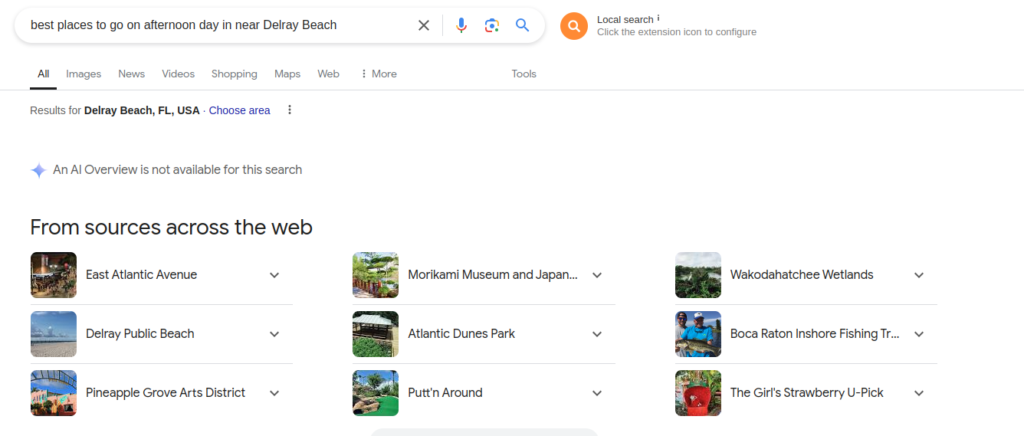It was not that long ago where communicating with robots was a fantasy. Today, we have AI assistants like Alexa, Siri, and Google Assistant with which we communicate daily to set reminders, check the weather forecast, and even order us a cup of morning coffee.
With advancements in speech search technology in recent years, voice search is now considered a key method for people to use digital products. In fact, Google revealed that 20% of all searches are now voice searches, and it is predicted to cross the 50% mark.
As more and more people are searching the internet with their voice, optimizing websites and content for voice search should be a top priority for business owners, especially small business owners.
Now, if you are not sure about what voice search is or how to optimize your business for the same, don’t worry, you are at the right place.
We will explain what voice search SEO is and how you can optimize your site so that your business shows up in the voice search results.
Let’s get to it!
How Voice Search Differs From Traditional Search
The main difference between traditional and voice searches is speaking your query instead of typing it out. While voice search offers the obvious advantage of convenience, it also introduces unique challenges and gives new opportunities for how search engines interpret and rank content.
Longer And More Conversational Searches

Voice searches are usually phrased differently than text searches. They are generally longer, precise and tend to be complete questions rather than just a few keywords. When we speak, we naturally use full sentences and include more detail than when we type.
However, the line between voice and traditional search is beginning to blur. As shown above, Google’s recent Gemini model is also capable of performing multiple steps of reasoning with input queries, and thus, users can now input longer and more complex queries. Recent work indicates that such AI Overviews are more likely to occur when the query is longer and resembles a prompt.
As users adapt to these advancements, voice and traditional search will likely become more similar in query length and conversational tone.
Local Listing Searches Include Voice Queries.

Another factor is that the majority of voice searches include the phrase “near me” together with questions like “When is the best time to go to Target?” or “Where is the nearest Taco stall?” These are local search queries, and the results are often in the local pack.
Having an up-to-date Google My Business Profile is important to confirm that your business appears in these searches.
Clear And Concise Search Results

Google featured snippets are short pieces of content that google highlights to answer your query at the top of the search results page. They’re extracted from a web page that ranks well for the query. These snippets can significantly boost your traffic.
Featured snippets are important for voice search because when a virtual assistant responds to a query, it often reads the featured snippet as the answer. To capture this valuable spot, you’ll need to optimize your content to win the featured snippet.
How to Optimize Your Website for Voice Search:
Optimizing website content for voice search includes researching for keywords for voice search SEO. These conversational keywords show a natural, question-based way people speak when using voice assistance. For example:
Typed query: Best hiking trails near me
Voiced query: What are the best hiking trails close to me?
However, not all users follow this pattern, and search behaviors can vary widely across different generations:
Baby Boomers (born 1946-1964): Personal knowledge preference is specific and elaborate questions with 5-7 words and use web search engines to locate information.
Gen X (born 1965-1980): Employ specific and general searching techniques, including web and social media searching.
Millennials (born 1981-1996): They are short and informal, focusing on mobile, voice, and social channels.
Gen Z (born 1997-2012): Prefer short and simple queries on social networks like TikTok and Instagram.
Gen Alpha (born 2013-present): Use voice-activated searches with simple and short keywords with no conjunctions or prepositions.
The best advice here is to understand your target audience. Analyze their demographics, preferences, and how they typically search for information. You can significantly improve your website’s visibility and attract more organic traffic by tailoring your content and keywords to their specific search behaviors.
Optimize For Long-Tail Keywords
When optimizing your website for voice search, use long-tail keywords, especially questions-based searches. This approach helps capture traffic from users who are likely to ask longer, more specific queries.
A longtail keyword is of three or more words. For example, searching for “spas in the Denver area” rather than just “spas” can reduce competition and make ranking higher easier.
To find relevant question keywords, use the common 4Ws and 1H formula “who,” “what,” “when,” “where,” and “how”. Adding these words to your content, particularly in headings (such as H2), and answering them briefly, which can raise your chances of ranking high in search engines.
Structure Your Content With Schema Markup
Schema markup is a useful tool for improving your website’s on-page SEO. This structured data type involves adding code to your website’s HTML to help search engines understand and show more detailed information, such as your business hours, address, contact details, pricing, and reviews.
Although Schema markup is for human visitors, it plays a huge role in ranking your website on search engines. By making your site more relevant in search engines’ eyes, schema markup also boosts your chances of appearing in voice search results.
Make Your Website Mobile-Friendly
With the rise of the accessibility of mobile devices, people browse the internet on their mobiles, so much so that over half of all global traffic originates from smartphones.
Google also considers the mobile user experience integrated into its algorithms. It is important to use responsive design to enhance your website for text and voice searches. Ensure that your site can be viewed across as many devices as possible and that it is optimized for the use of mobile devices, and you will be able to maintain your competitiveness and be ranked higher in the search engines.
Consult SEO Experts:
There are numerous voice search tools and resources available to optimize your website for voice search. Leverage these tools to monitor your site’s performance and stay updated on the latest voice search trends and best practices. For expert guidance, consider Milestone Marketing, which offers comprehensive solutions to enhance your voice search strategy and overall SEO.
At Milestone Marketing, we deliver tailored SEO strategies and cutting-edge solutions to boost your online presence. We are dedicated to helping businesses stay ahead with innovative approaches and expert insights in the ever-evolving technology.
The Future
With the advancement in voice search technology, businesses need to adapt to the latest voice search SEO to optimize their website. The basic principles of SEO remain the same, but the way people search for information is evolving. In the age of voice search, SEO should be done with a different approach. The content should be written in a conversational tone and should be able to answer the user’s query as soon as possible and in the simplest manner. In this way, by focusing on the user’s needs and offering the relevant data, you will be able to make your website popular in the future.



